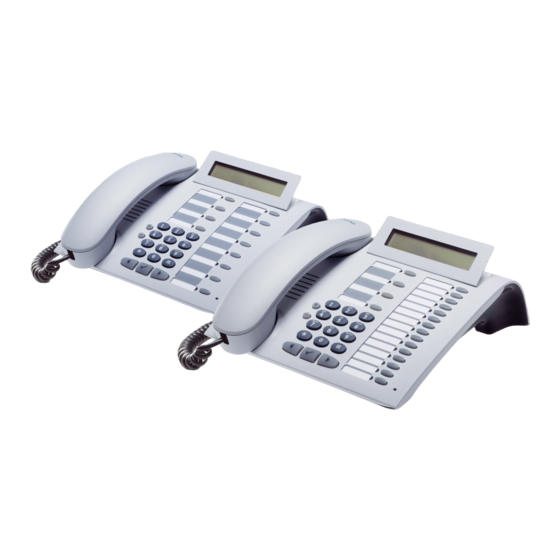
Summarization of Contents
Before You Begin
Important Notes
General warnings and precautions for phone usage, including safety and care instructions.
Marks
Explanation of certification marks and environmental compliance symbols.
Basic operating instructions
optiPoint 500 economy/basic/standard control panel
Description of the control panel layout for specific phone models.
How to Use these Operating Instructions
Guidance on understanding symbols and instruction formats for effective use.
Accessing Functions
Methods to find and activate phone features interactively, via menus, or function keys.
Functions You Can Use
Overview of available basic, team, and executive/secretary functions.
Making Calls
Basic Functions
Answering Calls
Procedures for receiving incoming calls via handset or speakerphone.
Making Calls
Methods for initiating calls using off-hook and on-hook dialing.
Redialing a Number
How to redial the last three dialed numbers.
Calling a Second Party (Consultation Hold)
How to add a third party or consult before transferring a call.
Call Forwarding
Setting up to redirect incoming calls to different destinations.
Telephone Settings
Adjusting ring volume, tone, and other phone parameters.
Making Calls
Convenience Functions
Rejecting Calls
How to decline incoming calls.
Answering Calls from the Entrance Telephone and Opening the Door
Interacting with door intercom systems to speak and open doors.
Using a Caller List
Accessing and managing a list of incoming calls.
Speed-dial
Storing and using speed dial numbers for quick dialing.
Dialing from the Telephone Database (LDAP)
Searching and dialing via an external LDAP database.
During a Call
Managing calls with features like call waiting and holding.
Conducting a Conference
Setting up and managing multi-party conference calls.
Using Night Answer
Forwarding calls automatically during off-hours or breaks.
Saving Functions, Procedures and Appointments
Assigning Functions to Keys
Customizing phone keys with frequently used functions or numbers.
Appointments Function
Setting up reminders for appointments via the phone.
Private Sphere/Security
Turning Do Not Disturb On and Off
Activating DND to prevent incoming calls and manage availability.
Caller ID Suppression
Preventing your number from being displayed to external parties.
Locking the Telephone to Prevent Unauthorized Use
Securing the phone with a PIN to prevent unauthorized access.
Using Other Functions
Sending a Message
Transmitting short text messages to users or groups.
Using Another Telephone Like Your Own
Allowing others to use your phone for outgoing calls temporarily.
Resetting Services and Functions (System-Wide Cancellation for a Telephone)
Performing a general reset of activated functions on the telephone.
Using System Functions from the Outside (DISA: Direct Inward System Access)
Accessing system features and activating functions remotely.
Team and Executive/Secretary Functions With Trunk Keys
Using Trunk Keys
Understanding and using trunk keys for team communication.
Using DSS Keys
Direct Station Selection keys for team communication.
Transferring Calls Directly to the Executive (Only in an Executive/Secretary Group)
Routing calls specifically to an executive via a secretary.
Testing the Telephone
Testing the Telephone Functions
Performing a diagnostic test of phone features and components.
Checking the Key Assignment
Verifying which functions are assigned to specific phone keys.
Special Functions in the LAN (PC Network)
Leaving a Hunt Group/Group Call
Exiting or joining group call functions within the network.
Opening the Door
Activating door openers remotely via the phone system.
Labeling, Documentation and Accessories
Labeling Key Fields
How to label phone keys with functions or call numbers.
Accessories
Overview of optional phone accessories for customization.
Fixing Problems
Telephone Maintenance
Guidelines for cleaning and maintaining the phone.
Troubleshooting
Basic steps for resolving common issues like unresponsive keys or no ringing.
Responding to Error Messages on the Screen
Understanding and resolving display error messages.














Need help?
Do you have a question about the optiPoint Series and is the answer not in the manual?
Questions and answers